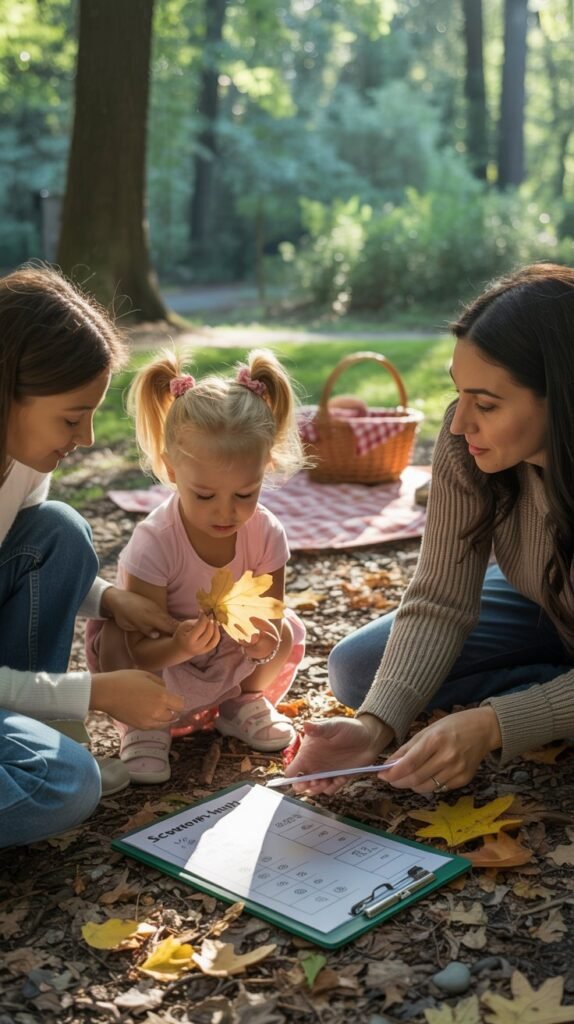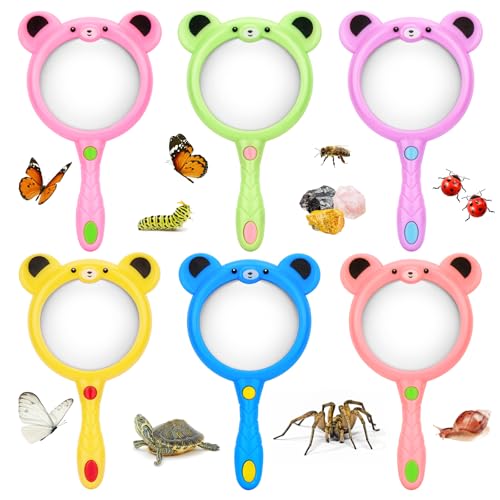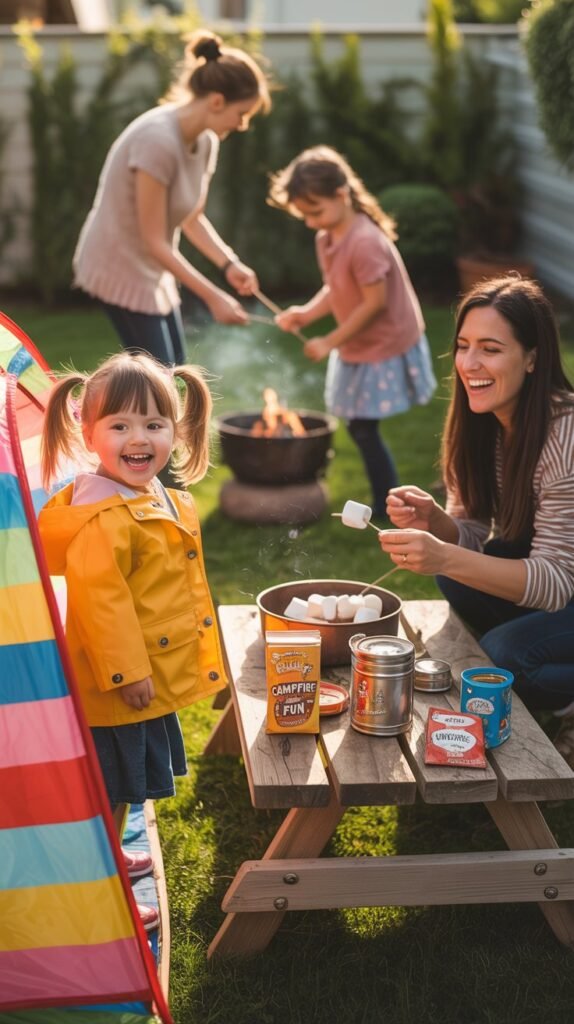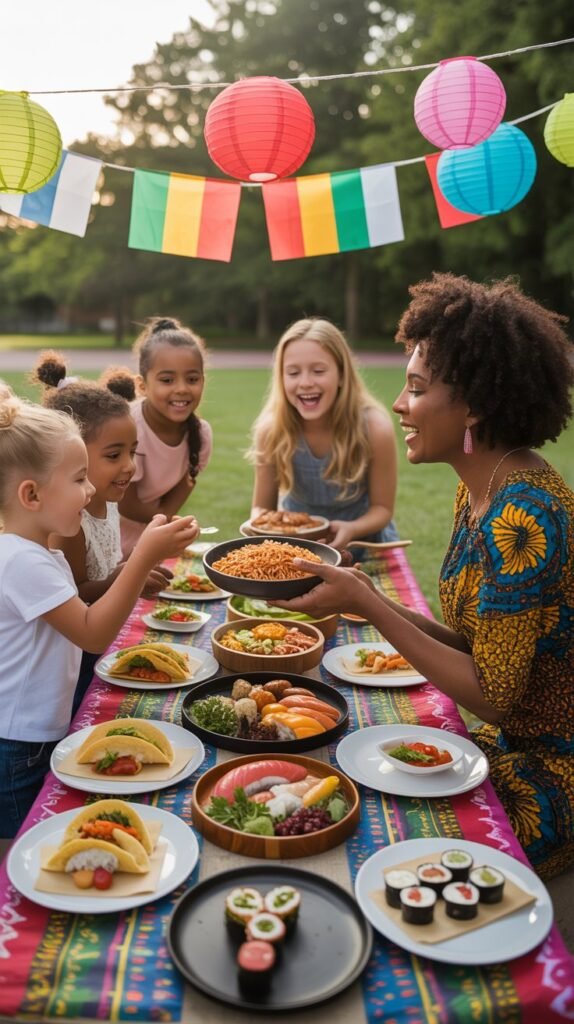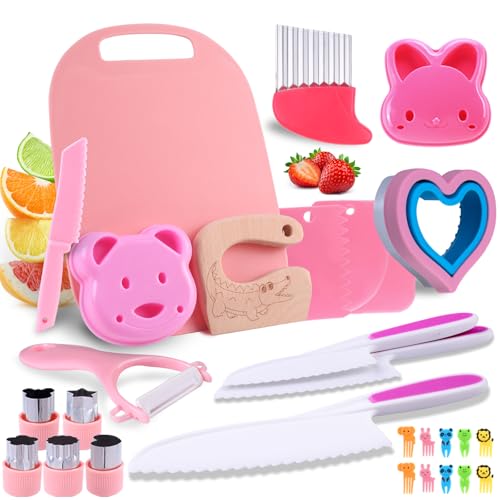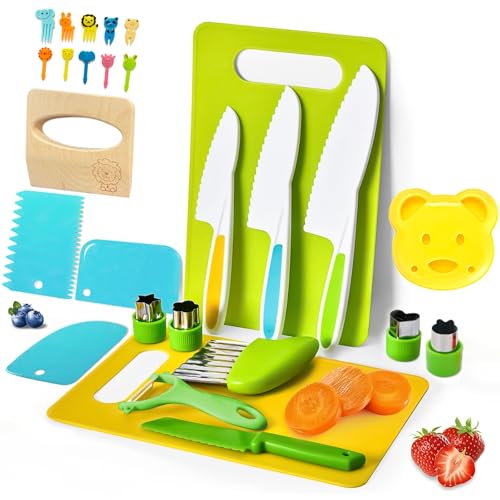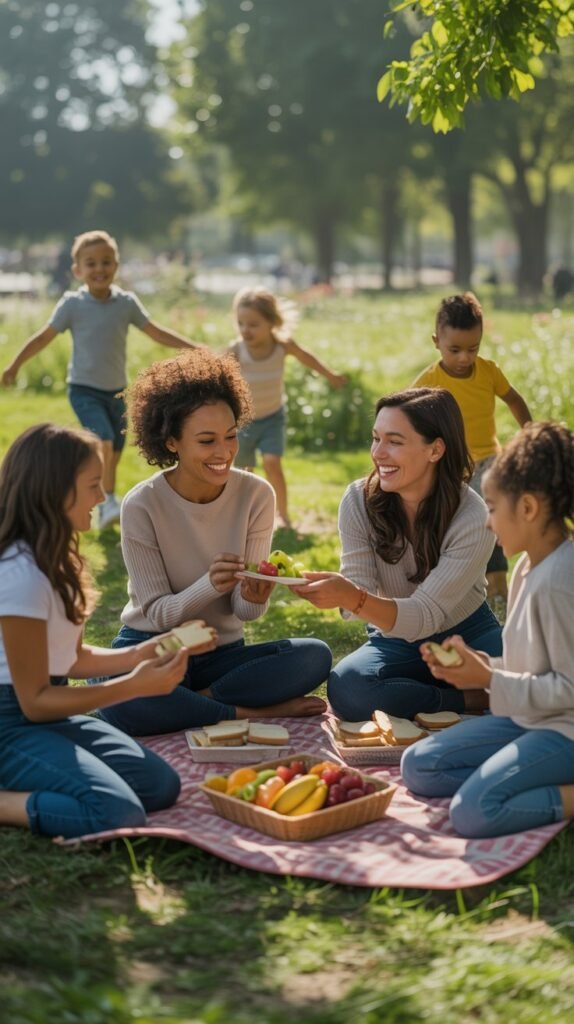Introduction: Creating Community One Picnic at a Time
There’s something absolutely magical about bringing families together outdoors! As moms, we all know how important it is to build connections—not just for ourselves, but for our little ones too. Picnic gatherings create those perfect, relaxed environments where kids can be kids while we actually get to have real conversations with other adults (imagine that!).
The beauty of organized picnic gatherings is how they naturally bring out the best in everyone. Kids learn to share, play with new friends, and experience different family dynamics, while we moms get the support, laughter, and connection we all crave. Plus, there’s something about the outdoor setting that makes even the most energetic kids more manageable and conversations more meaningful.
Ready to transform your usual solo family outings into community celebrations? Let’s dive into these fantastic ideas that will help you build lasting friendships while creating magical memories for your kids!
1. Teddy Bear Picnic Gathering
There’s nothing more adorable than watching a group of little ones introduce their beloved teddy bears to each other! This charming theme appeals to younger children and creates the sweetest photo opportunities you could ever imagine. The teddy bear picnic brings out the nurturing side in kids while giving them a comfortable conversation starter.
What makes this gathering extra special is how it combines imaginative play with social interaction. Kids feel confident bringing their favorite stuffed friend, which helps shy little ones feel more comfortable in group settings. Meanwhile, moms get to witness the most precious interactions as children share stories about their bears and create new friendships.
Planning Essentials
Coordination tips: Send out invitations that encourage each child to bring their favorite teddy bear and share one special thing about them. Create simple name tags for both kids and bears to help everyone remember new friends. Plan activities like a teddy bear parade, bear introductions, and group photos that celebrate each special stuffed friend.
Age considerations: This theme works best for ages 2-6, when stuffed animals are central to children’s play. Provide backup stuffed animals for children who might forget or prefer to keep theirs at home. Plan activities that include both active play and quiet snuggle time with the bears.
Food logistics: Create a “teddy bear feast” with finger foods that are easy for little hands to manage. Consider bear-shaped sandwiches, honey-themed snacks, and small portions that won’t overwhelm young appetites. Set up a special “bear table” where the stuffed animals can “eat” alongside their children.
2. Playground Picnic Meet-Up
Sometimes the best gatherings are the simplest ones! Organizing regular playground picnic meet-ups creates consistent opportunities for both kids and moms to build friendships. The playground provides natural entertainment while the picnic element adds structure and social focus to what might otherwise be a quick play session.
The beauty of playground picnics is how they work for a wide range of ages and energy levels. While younger kids enjoy the equipment, older children can play group games, and everyone benefits from the shared meal experience. For moms, it’s the perfect balance of child supervision and adult conversation.
Planning Essentials
Location selection: Choose playgrounds that offer age-appropriate equipment for your group’s children, adequate picnic table space, and good sightlines for supervision. Look for parks with clean restrooms, parking convenience, and shade options for hot days.
Food coordination: Establish a simple rotation system where families take turns providing main dishes, sides, or snacks. This prevents the stress of over-planning while ensuring variety. Consider playground-friendly foods that can be eaten with minimal mess and maximum portability.
Safety considerations: Establish ground rules for playground safety when multiple families are present. Designate adult supervision zones and create a buddy system for older kids to help watch younger ones. Exchange contact information for emergencies and establish meeting points if anyone gets separated.
3. Story Time Picnic Circle
Combine the magic of storytelling with the joy of outdoor dining! Story time picnic circles create wonderful opportunities for kids to experience books in a new environment while building listening skills and imagination. It’s perfect for book-loving families and those wanting to encourage reading in their children.
The outdoor setting adds a special element to story time that makes even familiar books feel new and exciting. Kids love the cozy community feeling of listening together, and moms appreciate the built-in quiet activity that works for various ages. Plus, it’s a great way to share favorite books and discover new titles!
Planning Essentials
Book selection: Choose books that work well for group reading—clear illustrations, engaging plots, and appropriate length for outdoor attention spans. Consider bringing multiple shorter books rather than one long story. Encourage families to bring favorite books to share with the group.
Comfort setup: Create a cozy outdoor reading environment with large blankets, cushions, and shade. Position seating so all children can see the book illustrations clearly. Have a backup plan for windy days that might make pages difficult to manage.
Engagement strategies: Plan interactive elements like sound effects, simple songs, or discussion questions that keep kids engaged. Consider bringing props or stuffed animals that relate to the stories. Allow time for children to share their own stories or thoughts about the books.
4. Nature Scavenger Hunt Picnic
Turn your picnic into an adventure with nature scavenger hunts that get kids exploring while learning! This activity combines education with physical activity and social interaction, creating an experience that’s both fun and enriching. Kids love the treasure hunt aspect while inadvertently learning about their natural environment.
The scavenger hunt element keeps kids engaged and moving, which is perfect for those high-energy children who struggle with sitting still for traditional picnics. Meanwhile, the shared exploration creates natural opportunities for children to help each other and work together toward common goals.
Planning Essentials
Hunt design: Create age-appropriate lists that include common items kids can realistically find—different leaf shapes, smooth rocks, feathers, or flowers. Include both specific items (“find a red leaf”) and experiential goals (“listen for three different bird sounds”). Provide clipboards and pencils for each child.
Safety guidelines: Establish clear boundaries for exploration and rules about what items can be touched or collected. Teach children to observe rather than pick rare plants or disturb wildlife habitats. Designate adult supervisors for different areas to ensure safety while maintaining exploration freedom.
Educational opportunities: Bring field guides or nature identification books to help children learn about their discoveries. Plan discussion time where kids can share their finds and learn from each other. Consider bringing magnifying glasses or collection bags for closer examination of discoveries.
5. Backyard Camping Picnic Adventure
Bring the excitement of camping to your own backyard (or a friend’s!) with a camping-themed picnic that includes all the fun without the overnight logistics. This theme appeals to kids’ sense of adventure while keeping everything manageable for parents. It’s perfect for introducing younger children to camping concepts in a safe, familiar environment.
The camping theme naturally encourages imaginative play and gives kids experiences they might not otherwise have. From exploring tents to making s’mores, children get to experience adventure while parents maintain full control over timing and safety. It’s camping with all the fun and none of the stress!
Planning Essentials
Equipment coordination: Organize tent setup with other families—even if you don’t have tents, cardboard boxes or sheets over tables create “camping” spaces. Plan stations for different camping activities like s’mores making, nature exploration, and camping games. Ensure all fire-related activities have proper adult supervision and safety equipment.
Activity rotation: Create camping stations that groups can rotate through—tent exploration, outdoor cooking demonstrations, nature crafts, and camping games. This keeps kids engaged while managing group sizes at each activity. Plan both active and quiet camping activities to accommodate different energy levels.
Safety considerations: Establish clear rules for tent play, especially with multiple children. Ensure adult supervision for any fire or cooking activities. Plan for various ages by having both adventurous activities for older kids and gentler “camping” experiences for toddlers.
6. Beach Day Picnic Gathering
Take your picnic gathering to the beach for an unforgettable day of sun, sand, and social fun! Beach picnics offer unique experiences that kids absolutely love while providing natural entertainment that keeps everyone engaged. The beach setting creates a vacation-like atmosphere that makes ordinary picnic food feel special.
The combination of beach play and shared meals creates lasting memories for both kids and adults. Children can explore, build, splash, and discover while parents enjoy conversation with built-in entertainment for the kids. Just be prepared for sandy sandwiches and the best kind of tired kids at the end of the day!
Planning Essentials
Beach logistics: Choose beaches with family-friendly amenities like restrooms, parking, and lifeguards. Coordinate arrival times to claim adjacent spots for your group. Plan for both beach play and eating areas, considering wind, sun, and tide factors that affect comfort and safety.
Safety protocols: Establish water safety rules and supervision responsibilities among the adults. Ensure adequate sun protection for all family members and plan for regular reapplication of sunscreen. Create a buddy system for children and establish meeting points in case anyone gets separated.
Food management: Plan foods that travel well and won’t spoil in heat. Use sealed containers to prevent sand contamination and bring extra water for drinking and cleaning. Consider the challenge of eating with sandy hands and plan accordingly with wipes and easy-to-handle foods.
7. Farm-to-Table Picnic Experience
Combine education with outdoor dining by organizing visits to local farms that welcome families! Farm-to-table picnic experiences teach kids about food sources while providing unique settings for family gatherings. Many farms offer pick-your-own activities, animal interactions, and educational programs that enhance the picnic experience.
This type of gathering creates wonderful learning opportunities about agriculture, healthy eating, and where food comes from. Kids love meeting farm animals and understanding how their food is grown, while parents appreciate the educational value and unique setting that makes the day feel special and memorable.
Planning Essentials
Farm coordination: Contact local farms in advance to arrange group visits and understand their policies for outside food. Many farms have designated picnic areas and some offer farm-fresh ingredients you can incorporate into your meal. Confirm animal interaction opportunities and any seasonal activities.
Transportation logistics: Coordinate carpooling or meeting arrangements for families traveling to farm locations. Plan for potentially muddy or dusty conditions and advise families to dress appropriately. Ensure adequate parking and accessibility for all family members.
Educational integration: Prepare age-appropriate information about farming and food production to share with children. Bring cameras to document the learning experience and consider creating a group scrapbook. Plan questions that help kids connect their food to the farm environment.
8. Sports Day Picnic Tournament
Combine friendly competition with community dining! Sports day picnic tournaments create excitement and physical activity while building teamwork skills among children from different families. This theme works particularly well for older kids who enjoy organized games and competition, while still being adaptable for younger children.
The tournament format naturally creates teams that mix children from different families, encouraging new friendships and cooperation. Parents can participate as coaches, referees, or cheerleaders, creating an atmosphere of family fun that emphasizes participation over winning.
Planning Essentials
Equipment organization: Coordinate sports equipment among families to ensure adequate supplies for planned activities. Include options for different skill levels and ages—from simple ball toss games for toddlers to more complex relay races for older children. Plan backup activities for varying group sizes.
Team creation: Develop fair team-making strategies that mix ages and abilities while encouraging new friendships. Consider family mixing to help children interact with kids they don’t know well. Create team names and simple identification methods like colored bandanas or stickers.
Competition structure: Design activities that emphasize fun and participation rather than intense competition. Include both individual and team events to accommodate different personalities. Plan recognition for various achievements—effort, teamwork, improvement, and good sportsmanship.
9. Art in the Park Picnic Session
Transform your picnic into a creative outdoor studio! Art in the park sessions combine the inspiration of natural settings with hands-on creative activities that kids love. The outdoor environment provides both subject matter and materials for nature-inspired art projects, while the group setting allows children to share ideas and techniques.
Outdoor art experiences are naturally less messy than indoor crafting (hello, grass stains are easier than paint on furniture!), and the relaxed atmosphere encourages creativity and experimentation. Kids love showing off their creations to other families, building confidence and artistic appreciation.
Planning Essentials
Supply coordination: Plan art projects that work well outdoors—consider wind, sunlight, and lack of running water. Choose washable, non-toxic materials appropriate for various ages. Coordinate supplies among families to ensure adequate materials without everyone bringing everything.
Project selection: Choose activities appropriate for mixed age groups—leaf rubbings, nature collages, rock painting, or simple watercolors. Plan projects that can be completed within reasonable time frames and don’t require extensive drying time. Include both structured and free-form creative options.
Environmental considerations: Select art activities that are environmentally responsible—avoid permanent markers near plants, choose biodegradable materials when possible, and plan for complete cleanup. Teach children to respect the natural environment while using it as inspiration.
10. Garden Party Picnic Gathering
Create an elegant outdoor dining experience that combines sophistication with family fun! Garden party picnics offer opportunities to teach children about plants and gardening while enjoying beautiful natural settings. Many botanical gardens, community gardens, or even well-maintained public gardens provide perfect backdrops for these special gatherings.
The garden setting naturally encourages quieter activities and appreciation for natural beauty, making this ideal for families who enjoy more peaceful gatherings. Children learn about different plants, flowers, and growing processes while adults enjoy the serene environment and meaningful conversations.
Planning Essentials
Location coordination: Arrange visits to botanical gardens, community gardens, or public gardens that welcome families and picnicking. Confirm policies about outside food and group gatherings. Consider gardens with educational programs or guided tours that can enhance your visit.
Educational activities: Prepare simple plant identification games, gardening vocabulary lessons, or flower pressing activities. Bring magnifying glasses for closer examination of plants and flowers. Plan discussions about plant care, growing cycles, and the importance of gardens in communities.
Refined atmosphere: Choose foods and presentation that complement the elegant garden setting—think finger sandwiches, fresh fruit, and beautiful table settings. Include flowers in your table decoration and encourage children to appreciate the beauty around them.
11. International Food Festival Picnic
Celebrate diversity and expand culinary horizons with international food festival picnics! Encourage each family to bring dishes representing their cultural heritage or favorite international cuisines. This creates wonderful opportunities for cultural education while introducing children to new flavors and traditions.
These gatherings naturally promote inclusivity and cultural appreciation while satisfying everyone’s curiosity about different foods and traditions. Kids learn that families have different backgrounds and traditions, fostering acceptance and interest in diverse cultures from an early age.
Planning Essentials
Cultural coordination: Encourage families to share the cultural significance or personal stories behind their chosen dishes. Provide small cards where families can write about their food’s origin or preparation. Plan for variety in flavors, spice levels, and dietary restrictions.
Educational opportunities: Bring world maps or cultural books to enhance learning about different countries and traditions. Encourage children to ask questions about different foods and cultures. Plan simple cultural activities like learning basic greetings in different languages.
Inclusive planning: Ensure that families feel comfortable participating regardless of their cultural background—encourage everyone to share any international cuisine they enjoy, not just their heritage. Plan for various dietary restrictions and allergies when dealing with diverse foods.
12. Science Discovery Picnic Lab
Transform your outdoor gathering into a hands-on science laboratory! Science discovery picnics combine education with experimentation, using natural settings and safe materials to conduct engaging experiments that captivate children’s curiosity. The outdoor environment provides endless opportunities for scientific exploration and discovery.
Kids love the hands-on nature of science experiments, and the group setting allows them to share discoveries and learn from each other’s observations. Parents appreciate the educational value while enjoying the enthusiasm and wonder that science activities naturally generate in children.
Planning Essentials
Experiment selection: Choose safe outdoor experiments appropriate for various ages—nature observation, simple chemical reactions using household items, or physics demonstrations using natural materials. Plan experiments that work well in outdoor conditions without requiring complex equipment.
Safety protocols: Ensure all experiments use child-safe materials and include proper supervision. Establish clear safety rules and provide appropriate protective equipment when needed. Plan for proper disposal of experiment materials and environmental protection.
Educational goals: Connect experiments to children’s everyday experiences and natural curiosity. Encourage observation, hypothesis formation, and discussion of results. Bring simple recording sheets where children can document their discoveries and observations.
13. Music and Movement Picnic Party
Fill your gathering with joy through music and movement! Musical picnic parties combine the universal appeal of music with physical activity and social interaction. Bring simple instruments, plan group singing activities, and encourage movement that gets everyone participating regardless of musical ability.
Music naturally brings people together and creates an atmosphere of celebration and joy. Children love the freedom to make noise outdoors, explore instruments, and express themselves through movement. Meanwhile, parents enjoy the infectious energy and community feeling that music creates.
Planning Essentials
Instrument coordination: Provide simple, child-safe instruments like shakers, tambourines, or rhythm sticks that multiple children can use. Plan for sharing and rotation of instruments. Include both structured musical activities and free exploration time.
Activity planning: Plan age-appropriate musical games, group singing of familiar songs, and movement activities that work for various physical abilities. Include both active and calm musical activities to accommodate different energy levels and personalities.
Sound considerations: Be mindful of park noise policies and other park users. Plan musical activities for appropriate times and locations. Consider battery-powered speakers or acoustic activities depending on your venue and local regulations.
14. Seasonal Celebration Picnic Series
Create anticipation and tradition with seasonal celebration picnics throughout the year! Plan gatherings that celebrate different seasons, holidays, or natural changes, building traditions that families can look forward to annually. These themed celebrations create special memories while marking the passage of time in meaningful ways.
Seasonal themes provide natural decoration, activity, and food ideas while connecting children to natural cycles and cultural celebrations. Families develop shared traditions and children learn to anticipate and appreciate seasonal changes through these special gatherings.
Planning Essentials
Annual planning: Develop a calendar of seasonal celebrations that families can anticipate—spring flower festivals, summer solstice picnics, autumn harvest celebrations, or winter wonderland gatherings. Plan themes that take advantage of seasonal foods, decorations, and activities.
Weather preparation: Plan seasonal celebrations with appropriate weather considerations and backup plans. Include activities and foods that work well in different seasonal conditions. Consider indoor alternatives for extreme weather while maintaining seasonal themes.
Tradition building: Incorporate activities that can become annual traditions—photo taking in the same location, creating seasonal crafts, or sharing seasonal foods. Document celebrations to create memories families can look back on and compare year to year.
15. Mom’s Night Out Picnic (Kids Welcome!)
Sometimes moms need social time too! Plan gatherings that prioritize adult conversation and relaxation while still including children in family-friendly ways. These events recognize that parents need community and social support, creating opportunities for meaningful adult interaction with appropriate child supervision and activities.
The key is balancing adult social needs with child safety and entertainment. Plan activities that allow children to play independently while adults can have sustained conversations. Evening or weekend timing often works better for these more adult-focused gatherings.
Planning Essentials
Timing considerations: Plan gatherings at times that work for both adult conversation and appropriate child activities—perhaps late afternoon into early evening, or weekend times when families are more relaxed. Consider scheduling that accommodates different family routines and nap times.
Activity balance: Include activities that allow children to play independently or with minimal adult intervention while still maintaining appropriate supervision. Plan both child activities and adult conversation areas that allow for interaction between the two.
Social atmosphere: Create an environment where adults can have meaningful conversations while remaining attentive to children’s needs. Consider bringing simple activities that keep kids engaged but don’t require constant adult participation.
16. Community Service Picnic Project
Combine outdoor dining with meaningful community service! These gatherings teach children about giving back while creating positive impact in your local community. Many parks, community organizations, or local charities welcome family volunteer groups, and the picnic element makes service work feel celebratory rather than burdensome.
Children learn valuable lessons about community responsibility and helping others while participating in activities that make a real difference. Parents model civic engagement and create opportunities for families to work together toward common goals that benefit everyone.
Planning Essentials
Service coordination: Contact local organizations to arrange appropriate volunteer activities for families with children. Plan projects suitable for various ages—park cleanup, community garden maintenance, or simple charity preparation activities. Confirm safety requirements and provide necessary equipment.
Age-appropriate activities: Select service projects that children can meaningfully participate in without becoming frustrated or unsafe. Plan roles for different age groups and abilities. Include education about why the service work is important and how it helps the community.
Celebration element: Combine service work with celebration to help children see community service as positive and rewarding. Plan special foods or small recognition activities that acknowledge everyone’s contribution to the community project.
17. Fitness and Fun Picnic Workout
Combine healthy living with social gathering through fitness-focused picnic workouts! These active gatherings promote physical activity for both adults and children while creating fun, non-intimidating exercise experiences. The outdoor setting and social atmosphere make exercise feel like play rather than work.
Fitness picnics model healthy lifestyle choices for children while providing adults with social exercise opportunities. Kids learn that physical activity can be fun and social, while parents get the motivation and support of exercising with friends.
Planning Essentials
Activity selection: Choose family-friendly exercises that work for various fitness levels and ages—group walking, simple yoga, playground workouts, or active games. Plan activities that feel fun rather than challenging or competitive. Include both structured exercise and free play opportunities.
Equipment coordination: Plan exercises that require minimal equipment or coordinate equipment sharing among families. Include activities that use natural environment features like park benches, trees, or open spaces for creative workouts.
Health considerations: Ensure activities are appropriate for all fitness levels and include modifications for different abilities. Plan for adequate hydration and rest breaks. Include healthy food options that complement active lifestyles.
18. Photography Walk Picnic Adventure
Combine artistic exploration with outdoor adventure through photography walk picnics! These creative gatherings teach children photography basics while exploring natural environments that provide beautiful subject matter. The combination of artistic education and outdoor exploration appeals to creative children and parents alike.
Photography activities naturally encourage observation, patience, and appreciation for natural beauty. Children learn to see their environment with new eyes while developing creative skills and artistic confidence.
Planning Essentials
Equipment coordination: Provide child-safe cameras—disposable cameras, simple digital cameras, or phone cameras with protective cases. Plan for equipment sharing and establish rules for camera care and safety. Include basic photography instruction appropriate for different ages.
Location selection: Choose locations with varied and interesting photographic opportunities—nature scenes, architectural details, or seasonal features. Plan routes that are manageable for children carrying camera equipment while providing diverse subject matter.
Skill development: Include basic photography lessons about composition, lighting, and subject selection appropriate for children’s understanding. Plan sharing time where children can show their photos and receive positive feedback from the group.
19. Cooking Class Picnic Experience
Transform your gathering into an outdoor cooking school! Cooking class picnics combine culinary education with hands-on learning experiences that kids absolutely love. Teaching children cooking skills in a group setting makes the learning more social and fun while providing practical life skills they’ll use forever.
The outdoor setting makes cooking feel like an adventure rather than a chore, and the group dynamic encourages children to try new foods and techniques they might resist at home. Parents appreciate the educational value while enjoying the shared experience of creating delicious food together.
Planning Essentials
Safety coordination: Plan cooking activities appropriate for outdoor settings and various ages—no-cook recipes, simple assembly dishes, or carefully supervised basic cooking techniques. Ensure adult supervision for any heat or sharp tools. Establish clear safety rules and provide appropriate equipment.
Recipe selection: Choose recipes that work well outdoors and can be completed within reasonable time frames. Plan for varying skill levels and include tasks that different ages can successfully complete. Consider foods that can be eaten immediately or don’t require extensive cooking time.
Equipment planning: Coordinate cooking equipment among families and plan for outdoor cooking challenges like wind, limited counter space, and cleanup considerations. Include hand washing stations and adequate workspace for multiple families cooking together.
20. Talent Show Picnic Performance
Celebrate every child’s special talents with performance picnic gatherings! Talent show picnics create supportive environments where children can showcase their unique abilities while building confidence and learning to appreciate others’ talents. The informal outdoor setting makes performing feel less intimidating while still creating special moments for recognition.
These gatherings help children develop performance confidence while learning to be appreciative audiences for their friends. The supportive community atmosphere ensures that every child feels celebrated regardless of their talent type or skill level.
Planning Essentials
Performance environment: Create a supportive, non-competitive atmosphere where all talents are celebrated equally. Plan simple staging areas using picnic blankets or natural features. Include opportunities for both prepared performances and spontaneous sharing.
Talent inclusion: Encourage all types of talents—singing, dancing, magic tricks, joke telling, sports skills, or creative arts. Plan for performances that require minimal equipment or coordination. Include group performances that allow shy children to participate with friends.
Recognition planning: Plan recognition that celebrates participation and uniqueness rather than competition. Consider simple certificates, applause, or group photos that make every child feel special. Include opportunities for audience participation and engagement.
Tips for Successful Group Picnic Organization
The difference between a chaotic gathering and a memorable celebration often comes down to thoughtful organization! But don’t worry—with some simple planning strategies, you can create gatherings that feel effortless while actually being well-coordinated behind the scenes.
Communication strategies: Establish clear communication channels for coordinating with multiple families. Use group texts, shared online calendars, or simple email chains to share details, coordinate food contributions, and update plans. Create simple templates for gathering information from families about food allergies, contact information, and children’s ages.
Weather planning: Always have backup plans for weather challenges! Choose venues with covered areas or indoor alternatives, plan activities that can move indoors if needed, and communicate weather decisions clearly to all families. Keep emergency contact information readily available and establish protocols for last-minute changes.
Inclusive coordination: Create environments where all families feel welcome regardless of their background, budget, or family structure. Plan activities that work for various ages and abilities, coordinate food contributions fairly, and ensure that participation doesn’t become financially burdensome for any family.
Building Your Mom and Kids Community
The most beautiful outcome of organized picnic gatherings is the community that naturally develops! These shared experiences create bonds between families that extend far beyond individual events, building support networks that enrich both children’s and parents’ lives in lasting ways.
Friendship development: Regular gatherings provide opportunities for both children and adults to develop meaningful friendships. Kids learn social skills, conflict resolution, and the joy of group play, while parents build support networks that provide both practical help and emotional connection during the challenges of raising children.
Community building: Organized gatherings often evolve into informal support networks where families help each other with childcare, share parenting resources, and provide community during difficult times. These connections create resilience and joy that benefit entire families.
Social skill development: Children learn valuable social skills through regular interaction with diverse families—sharing, cooperation, empathy, and appreciation for differences. These skills benefit them throughout their lives and contribute to building more compassionate communities.
Safety and Logistics for Group Events
Safety becomes even more important when coordinating multiple families! With thoughtful preparation, you can create environments where everyone feels secure and parents can actually relax and enjoy the gathering.
Supervision strategies: Establish clear supervision responsibilities and ratios that ensure adequate adult attention for all children. Create systems for knowing where children are at all times and establish boundaries that all families understand and enforce consistently.
Emergency preparedness: Maintain updated emergency contact information for all families, ensure adequate first aid supplies and trained responders, and establish clear protocols for handling medical emergencies or severe weather. Communication plans ensure all families can be reached quickly if needed.
Allergy management: Develop systems for managing food allergies and dietary restrictions that keep all children safe while still allowing for diverse food sharing. Clear labeling, designated allergy-free areas, and emergency medication protocols protect vulnerable children while maintaining inclusive gatherings.
Conclusion: The Joy of Shared Outdoor Experiences
These picnic gathering ideas are just the beginning of the beautiful community you can build through shared outdoor experiences! The connections formed over shared meals, children’s laughter, and supportive conversations create ripple effects that enhance every family’s life in ways both large and small.
Remember, the most important ingredient in any successful gathering isn’t the perfect weather or elaborate planning—it’s the intention to create connection and joy. Start small, keep it simple, and focus on the relationships rather than the perfection. Some of the most treasured memories come from the most unexpected moments!
Every gathering you organize contributes to building stronger communities for our children and support networks for ourselves. In our busy, often isolated world, these simple outdoor celebrations create the human connections we all crave and our children desperately need.
So grab that picnic blanket, reach out to other families, and start building the community of your dreams—one shared meal, one new friendship, and one joyful outdoor adventure at a time. Your future self (and your children) will thank you for the effort you put into creating these magical shared experiences!











